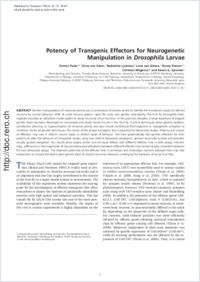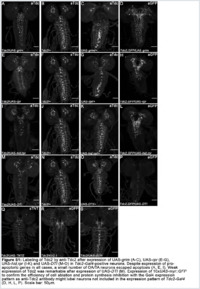Potency of transgenic effectors for neurogenetic manipulation in Drosophila larvae
- Pauls, Dennis Neurobiology and Genetics, Theodor-Boveri-Institute, Biocenter, University of Würzburg, Germany
- Essen, Alina von Department of Biology, University of Fribourg, Switzerland
- Lyutova, Radostina Neurobiology and Genetics, Theodor-Boveri-Institute, Biocenter, University of Würzburg, Germany
- Giesen, Lena van Department of Biology, University of Fribourg, Switzerland
- Rosner, Ronny Department of Biology, Animal Physiology, Philipps-University Marburg, Germany - Institute of Neuroscience, Newcastle University, Newcastle upon Tyne, United Kingdom
- Wegener, Christian Neurobiology and Genetics, Theodor-Boveri-Institute, Biocenter, University of Würzburg, Germany
- Sprecher, Simon G. Department of Biology, University of Fribourg, Switzerland
-
01.01.2015
Published in:
- Genetics. - 2014, vol. 199, no. 1, p. 25–37
English
Genetic manipulations of neuronal activity are a cornerstone of studies aimed to identify the functional impact of defined neurons for animal behavior. With its small nervous system, rapid life cycle, and genetic amenability, the fruit fly Drosophila melanogaster provides an attractive model system to study neuronal circuit function. In the past two decades, a large repertoire of elegant genetic tools has been developed to manipulate and study neural circuits in the fruit fly. Current techniques allow genetic ablation, constitutive silencing, or hyperactivation of neuronal activity and also include conditional thermogenetic or optogenetic activation or inhibition. As for all genetic techniques, the choice of the proper transgenic tool is essential for behavioral studies. Potency and impact of effectors may vary in distinct neuron types or distinct types of behavior. We here systematically test genetic effectors for their potency to alter the behavior of Drosophila larvae, using two distinct behavioral paradigms: general locomotor activity and directed, visually guided navigation. Our results show largely similar but not equal effects with different effector lines in both assays. Interestingly, differences in the magnitude of induced behavioral alterations between different effector lines remain largely consistent between the two behavioral assays. The observed potencies of the effector lines in aminergic and cholinergic neurons assessed here may help researchers to choose the best-suited genetic tools to dissect neuronal networks underlying the behavior of larval fruit flies.
- Faculty
- Faculté des sciences et de médecine
- Department
- Département de Biologie
- Language
-
- English
- Classification
- Biological sciences
- License
-
License undefined
- Identifiers
-
- RERO DOC 234203
- DOI 10.1534/genetics.114.172023
- Persistent URL
- https://folia.unifr.ch/unifr/documents/304104
Other files
Statistics
Document views: 87
File downloads:
- pdf: 166
- Supplementary material: 127

